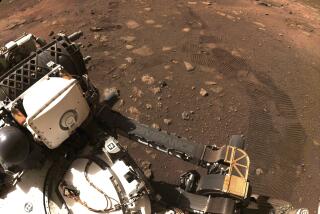Mars Curiosity rover on spring break after hitting pay dirt [video chat]
- Share via
NASA’s Curiosity rover is taking time off after the very first Martian rock it drilled turned out to be a hole-in-one, chock full of evidence that hypothetical microbes could have lived on the Red Planet.
In the rock known as John Klein, the Mars Science Laboratory rover found six elements key to life on Earth – hydrogen, oxygen, sulfur, nitrogen, phosphorus and carbon – as well as clays indicating an area once rich in water and salts hinting of a benign, low-acidity environment.
“Life as we know it, if it had been present when these rocks were being formed, would have been very happy living and thriving” in a place like this, Mars mission scientist Joel Hurowitz said in a video chat from Jet Propulsion Laboratory this week.
Scientists had been banking on finding such answers at Mount Sharp, a 3-mile-high mountain in the middle of Gale Crater whose clay-rich layers could reveal whether Mars was ever hospitable to life. But the rover team ended up making their ground-breaking discovery just 500 meters or so from Curiosity’s landing spot.
That big break came just in time, too: The sun is set to come between the Earth and Mars (a phenomenon called solar conjunction), blocking attempts to contact the rover. One can only imagine what the Curiosity (or at least, its Twitter avatars and impersonators) will get up to during its Martian “spring break.”
In the meantime, check out our chat with Hurowitz above for more details on Curiosity’s latest findings.
Follow me on Twitter @aminawrite.






